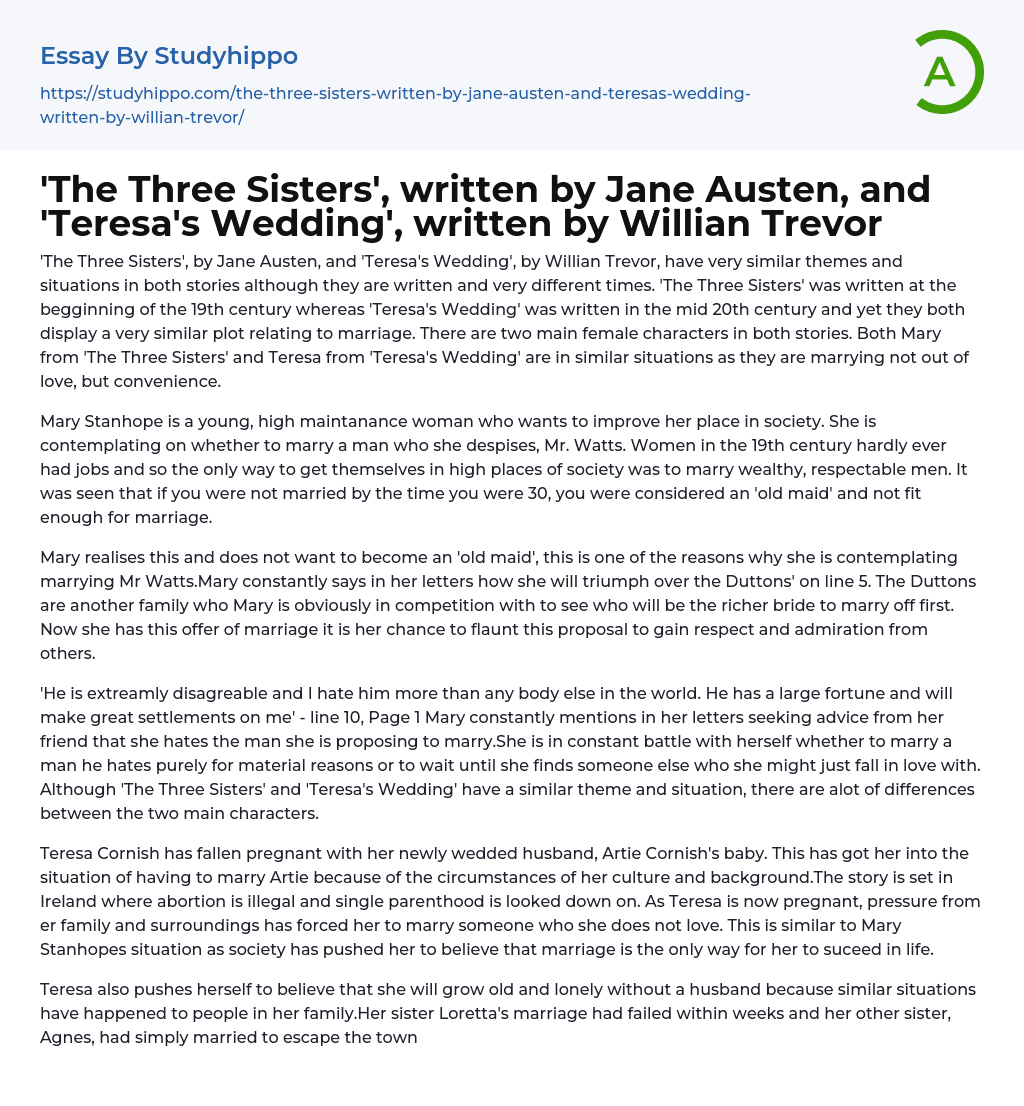

Similar Themes in Different Times: ‘The Three Sisters’ and ‘Teresa’s Wedding’
Although 'The Three Sisters' by Jane Austen and 'Teresa's Wedding' by William Trevor were written in different time periods, they both delve into comparable themes and situations. Despite being composed in the early 19th century and mid-20th century respectively, these narratives revolve around the common topic of marriage.
Both 'The Three Sisters' and 'Teresa's Wedding' showcase two female protagonists, Mary and Teresa, respectively. These characters share a common situation as they both enter marriages that are not driven by love but rather convenience. In the case of Mary Stanhope, she is a young woman with high expectations who desires to improve her social standing. She ponders the prospect of marrying Mr. [Last Name], whom she despises.
In the 19th century, women rarely had jobs and relied on marrying wealthy men to gain social
...standing. Being unmarried at 30 was seen as undesirable, but Mary does not want to be viewed as an 'old maid'. This is why she is considering marrying Mr Watts. Through her letters, Mary expresses her determination to outshine the Duttons, a competing family in the race to find a wealthy suitor. Mary sees this marriage proposal as an opportunity to gain respect and admiration from others.
'He is extremely disagreeable and I despise him more than anyone else in the world. He possesses a substantial fortune and will provide generous settlements for me.' (line 10, Page 1)
Mary consistently expresses in her letters to her friend that she detests the man she is considering marrying. She grapples with the decision of whether to marry a man she despises solely for material reasons or to wait for someone else whom she may actually fall in love
with. Although 'The Three Sisters' and 'Teresa's Wedding' share a common theme and situation, the two main characters have many differences. Teresa Cornish has become pregnant with her recently wedded husband, Artie Cornish's, child.
Teresa is forced to marry Artie because of cultural and societal expectations in Ireland. The country's strict laws against abortion and negative attitudes towards single parenting contribute to the pressure she faces. Despite not loving Artie, Teresa succumbs to the influence of her family and surroundings. Mary Stanhope shares a similar situation as society convinces her that marriage is necessary for success. Teresa also fears ending up old and alone without a husband, based on experiences within her own family. For example, Loretta's short-lived marriage and Agnes marrying solely to escape a disliked town serve as cautionary tales.
Teresa believes that she will end up in a similar situation, so she partially accepts her marriage to Artie as a safe choice to feel secure about her future. This mirrors Mary's circumstances in 'The Three Sisters' as Mary's society and surroundings have ingrained in her the belief that if she is not married by a certain age, her life will be hopeless. Although Teresa's marriage has been arranged for her, she is more optimistic than Mary. On page 437, Teresa expresses, 'She felt that she and Artie might make some kind of marriage together because there was nothing that could be destroyed, no magic or anything else'. Despite knowing there is no love in her marriage with Artie, she knows it will not be a failed one like her sisters', and the security she currently has will provide something in her life. On page
437, Teresa tells us, 'At least they had no illusions,' she thought. 'Nothing worse could happen than what had happened already, after Fath Hogan had laid down the law. She wasn't going to get a shock like Loretta had got.'
Both Teresa from 'Teresa's Wedding' and Mary from 'The Three Sisters' are marrying for convenience. Teresa is optimistic about her future life, while Mary is pessimistic due to her hatred towards her future husband. However, Mary is optimistic because her marriage will bring her a much wealthier and higher societal lifestyle than before. There is always a chance of love in their marriages despite not initially loving their husbands. Mary Stanhope seems to be a high maintenance, vain woman with high expectations for her future. Mr. Watts, the man she eventually agrees to marry, also appears vain and arrogant. Given their similarities in personality, there is a possibility that Mary Stanhope and Mr. Watts may fall in love once they spend their married life together, similar to Teresa and Artie Cornish.
Despite Teresa's arranged marriage to a man she does not love, there is potential for love to develop as they continue their married life and get to know each other better. Both stories emphasize the enduring cultural and societal pressure for women to marry, despite being written in different time periods.
- Allegory essays
- Alliteration essays
- Comedy essays
- Comic book essays
- Drama essays
- Dystopia essays
- Fairy Tale essays
- Fantasy essays
- Fiction essays
- Ghost essays
- Gothic Fiction essays
- Gothic Literature essays
- Irony essays
- Legend essays
- Memoir essays
- Novel essays
- Poetry essays
- Satire essays
- Science Fiction essays
- Short Story essays
- The western essays
- Tragedy essays
- Witchcraft essays
- Aldous Huxley essays
- Alice Walker essays
- Amy tan essays
- Anne Bradstreet essays
- Anton Chekhov essays
- Arthur Miller essays
- Augustine essays
- Bertolt Brecht essays
- Booker T Washington essays
- Carol ann duffy essays
- Charles Dickens essays
- Charlotte Perkins Gilman essays
- Chinua Achebe essays
- Christina Rossetti essays
- Consider The Lobster essays
- Edgar Allan Poe essays
- Elizabeth Bishop essays
- Emily Dickinson essays
- Ernest Hemingway essays
- F. Scott Fitzgerald essays
- George Orwell essays
- Harper Lee essays
- Homer essays
- James Baldwin essays
- Jane Austen essays
- John Donne essays
- John Steinbeck essays



